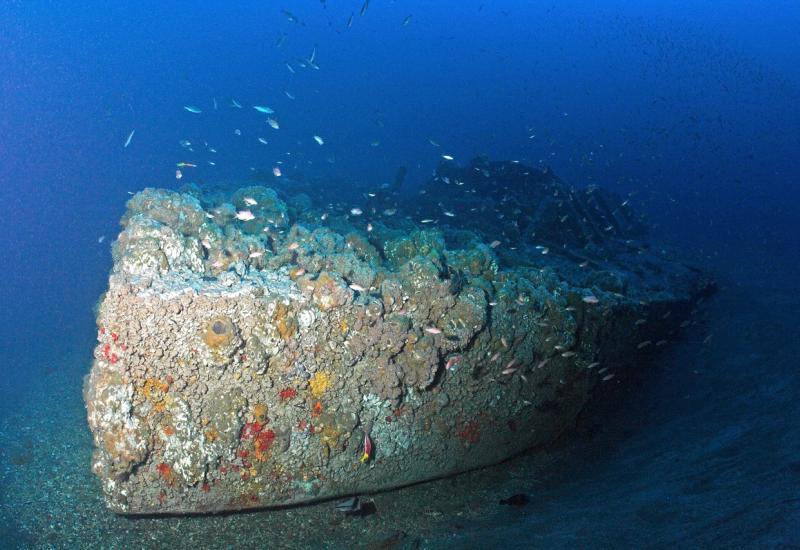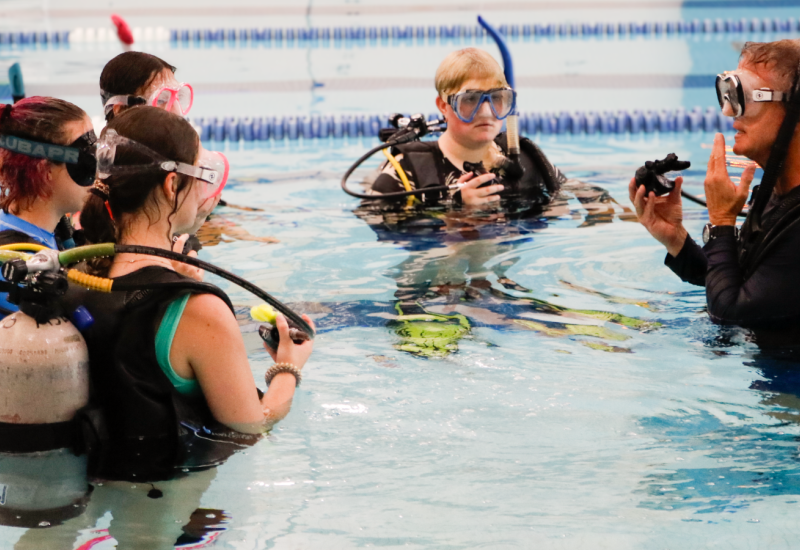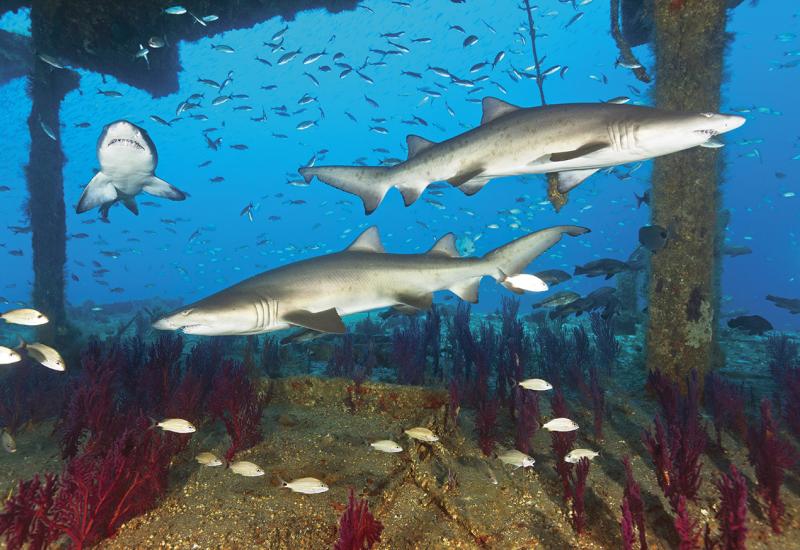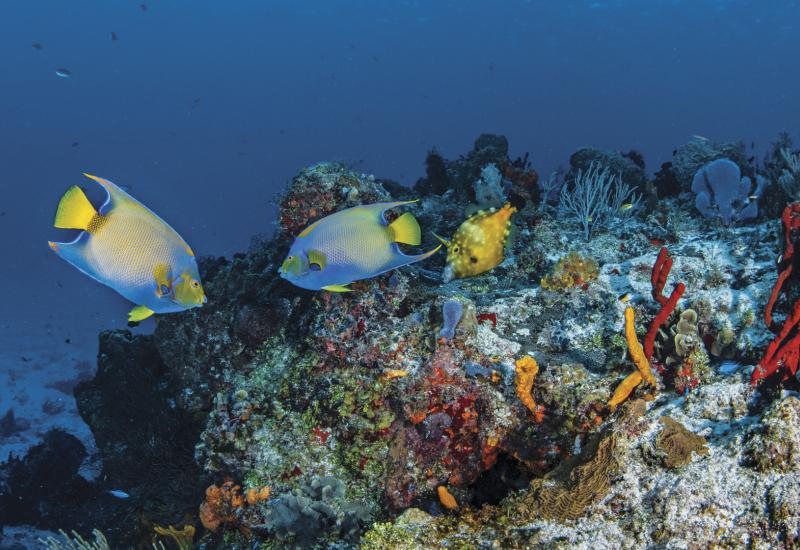The Wrecks of Carolina
 |
June 2000
By Sid Wise
Divers love it. Ship captains hate it. The North Carolina coast, known as the "Graveyard of the Atlantic," has claimed thousands of ships, from tugboats to U-boats, barges to dredges.
Some ran aground on the shallow shoals that jut from the famous capes--Fear, Lookout, Hatteras--and the beaches of Nags Head. Storms, pirates, cannon fire and torpedoes claimed even more victims and the late 20th century saw ships sunk on purpose as artificial reefs.
Hundreds of wrecks are within recreational diving limits, and in the summer dive season, Gulf Stream influences can make conditions almost Caribbean. And that's the best thing about this world-class collection of wrecks--you don't have to be a techie to dive them. No dry suits or double 80s required, just the common sense to stay within the envelope of your training, experience, skills and equipment.
Dive Drill
With the exception of a few nearshore wrecks, the most popular dives are found anywhere from 20 to 45 miles offshore. Two-tank day trips are the norm, but you can also charter overnight or even multi-day trips if you really want to explore.
Boat accommodations vary from tiny six-packs that barely hold divers and gear to 30-passenger crew boats. The ride is less bumpy on the larger boats, at the price of a more crowded dive. Most boats do not provide drinks or snacks, so bring your own.
For more information:
A dive club known as BFDC has a great web site with pictures and details of major N.C. wrecks, at www.nc-wreckdiving.com.
Safe Wreck Diving Tips
- Know your limits. North Carolina dive operators treat certified divers like big girls and boys and don't dictate profiles or behavior to their customers. It's up to you to make sure you and your equipment are up to the demands of the dive. It's also up to you to avoid unsafe penetration situations.
- Listen to briefings. Operators know these wrecks well and will provide a wealth of information on everything from the wreck's history to dive techniques and hazards to avoid.
- Get advanced training. Carolina shops can certify you in advanced dive techniques including deep diving and wreck penetration if you're interested. For difficult sites, some dive operators may require advanced training.
- Protect your skin. Current and surge around wrecks increase your risk of contacting something that hurts. A full wetsuit and gloves are recommended.
- Carry signaling devices. This is the open ocean. A safety sausage, mirror and loud noisemaker are smart precautions should you get separated from the boat.
 |
Dive Conditions
Diving the North Carolina coast can be terrific or it can be tricky, thanks to conflicting ocean currents that flow past the protruding coastline. Flowing north, the warm blast of the Gulf Stream comes closer to shore here than anywhere north of Florida. From the north flows the cold, green Labrador Current. The two generally meet at Cape Hatteras. Count on clearer, warmer and calmer water south of the Cape, colder, greener water plus stronger currents north of it.
- Surface conditions are unpredictable and can turn from flat calm to flat out calamity. Dive operators will cancel trips when conditions are too rough, but even when conditions are good, you might be in for a bumpy ride to the offshore sites. If you are susceptible to seasickness--and even if you aren't--a precautionary dose of Dramamine is a good idea, especially on smaller boats.
- Visibility averages 50 to 70 feet on most offshore sites, but can peak at 100 or more in the very best conditions, especially during the summer dive season when the Gulf Stream meanders closer to shore.
- Water temperature ranges from the low 70s to low 80s during the summer dive season (May to October), dropping to low 60s in winter. During summer, a full 3mm suit is recommended over shorties, to have added protection from cuts and scrapes. In the winter, plan on a dry suit or heavy neoprene and a hood.
- Currents vary according to conditions, season and sites. Dive operators will brief you on-site. Use caution when swimming near wreck openings as they can amplify currents.
Cape Lookout
U-352
Depth: 115 feet.
Skill Level: Advanced.
The most famous of three submarine dives off the Carolina coast, this World War II German U-boat was hunting Allied shipping in 1942 when she fired on--and missed--the Coast Guard Cutter Icarus. Big mistake. The cutter responded with a barrage of depth charges that killed 13 of the sub's crew and forced the U-boat to surface and surrender. After rounding up the surviving crew, Icarus turned her deck guns on the sub, sending her to the bottom for the final time.
Though her outer hull has long since rusted away, the inner hull is largely intact and encrusted with coral growth. Descending the anchor line to the wreck, it's easy to make out the cigar shape on the white sand bottom, though the lines may seem a bit fuzzy. Like most Carolina wrecks, the U-352 is a rare oasis of structure on the sand bottom and attracts swarms of baitfish seeking protection from predatory jacks.
The sub is half-buried and listing 45 degrees to starboard, but is still the classic picture of a U-boat. You can make out the shape of the conning tower, see the deck gun mounts and find open hatches. Just remember the first rule of Carolina wreck diving--never penetrate a wreck without proper training, equipment and experience.
Papoose
Depth: 120 feet.
Skill Level: Intermediate.
Blown apart by a U-boat torpedo in 1942, the tanker Papoose lies upside down on the sandy ocean floor, broken into sections. You can spend several dives just exploring the wreckage, but most divers get distracted early by the big sand tiger sharks that call the wreck home. Their size and rows of jagged teeth give these sharks a ferocious appearance, but they are generally docile. Their reaction to divers is often one of curiosity, and their mellow demeanor means you can get close for the pictures of a lifetime. Look for them on the wreck, which rises to 90 feet in spots, or on the sand at 120.
Indra
Depth: 65 feet.
Skill Level: Beginner.
Proof that not every great wreck dive has origins in tragedy, this former landing craft repair ship was sunk in 1992 as an artificial reef. She now sails upright and intact through the sand. Upper decks top out at a beginner-friendly 35 feet and Indra makes a great introduction to wreck diving for new divers. Located closer to shore, the wreck is easier to get to than most, but the vis is also lower.
Naeco
Depth: 140 feet.
Sill Level: Advanced.
Broken by a U-boat's torpedo, the Naeco sank in two sections two miles apart. The stern is the more interesting dive with open hull plates exposing a massive engine. Naeco is "ocean" spelled backwards--fitting for a wreck that lies at the very edge of the Gulf Stream. Constantly awash in warm water, the wreck is covered in a riot of tropical marine life. Look for butterflyfish, triggerfish, lobsters, grouper and morays. The long boat ride makes this less crowded than other wrecks, and the visibility is as good as it gets.
Cape Fear
Hyde
Depth: 80 feet.
Skill Level: Beginner.
Sunk in 1988, this artificial reef is covered with colorful growth as well as swirling schools of silver baitfish and colorful tropicals. Huge grouper also live on the Hyde, making it as popular with fishermen as divers, so watch for lures and lines. The wreck is nearly intact and there are plenty of diver-safe swim-throughs on deck.
John D. Gill
Depth: 90 feet.
Skill Level: Intermediate.
At 525 feet, this tanker is the largest ship sunk by a U-boat off North Carolina. She rests in two pieces, broken ahead of the stern. The ship's debris--anchor chain, tools from the deck, a gun platform--litter the bottom. The bow section has settled to one side, partially sunken into the sand. There are enough interesting features on and above deck that divers do not have to descend to the bottom to fully enjoy the dive. A half century of coral growth adds color and texture to the wreck and thousands of fish call it home. Look for amberjack, flounder and Atlantic spadefish.
Nags Head
USS Huron
Depth: 20 feet.
Skill Level: Intermediate to advanced.
An iron hulled steam-and-sail war sloop, the Huron was headed to Havana in 1877 when she ran aground on the shoals off Nags Head. A rare dive in the surf zone (expect strong surge and vis less than 10 feet), the wreck is now a Historic Shipwreck Preserve. The lower half of the Huron's iron hull is well-preserved and covered in coral growth, but shifting sands make the wreck a different dive every time. Wreckage, including cannon balls, the large four-blade propeller and the ship's rudder, is scattered through the site. Full wetsuits and gloves are recommended due to the cool water and surf action.
U-85
Depth: 100 feet.
Skill Level: Intermediate to advanced.
Nicknamed the Wild Boar, U-85 was the first German submarine sunk in American waters. Blasted by depth charges and raked with deck gun and machine gun fire, the sub was in sad shape when she went down. The sea has since peeled away the outer hull and replaced it with living layers of soft coral and algae over the intact pressure hull.
Divers reach the conning tower at 80 feet and the sand at 100 where the sub wallows on her starboard side, deck hatches open and her deck gun still pointed defiantly toward the surface. U-85's position around the corner of the Outer Banks means she's exposed to cooler, greener water of the Labrador Current, so expect strong currents, summer water temperatures of 55F to 60F and visibility hovering somewhere around 30 feet.
Cape Hatteras
USS Tarpon
Depth: 140 feet.
Skill Level: Advanced.
The Tarpon is a U.S. submarine that spent World War II in the Pacific, sinking nine Japanese ships and one German warship. Retired and then sold for scrap in 1957, she was being dragged to the cutting yard when the tow cable broke and the sub made a final dive for the bottom. The years have not been kind to this stubborn American hero--her bow is broken and her conning tower sheared off by drag nets, but the sub is still a popular dive. Though deep by recreational standards and swept by strong currents, visibility is usually very good.
Proteus
Depth: 120 feet.
Skill Level: Advanced.
Proteus was a passenger steamer that ferried travelers from New Orleans to New York. On a foggy August morning in 1918, she collided head-on with the tanker Cushing. The tanker survived and rescued all aboard the Proteus before she sank to the bottom less than half a mile from where the Tarpon would sink 40 years later. A popular dive among artifact collectors, the ship also sports more than 80 years of coral growth and serves as a haven for tropical fish.
|| |---|
|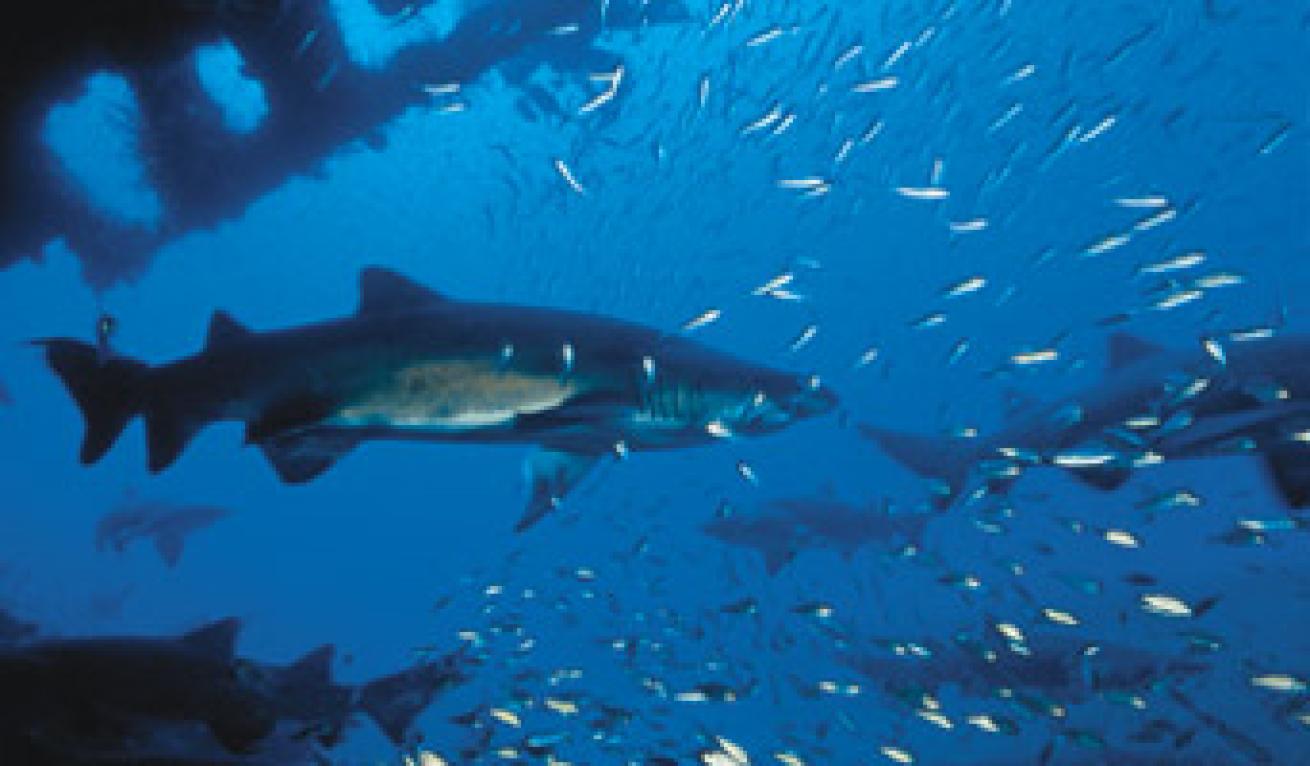
|
June 2000
By Sid Wise
Divers love it. Ship captains hate it. The North Carolina coast, known as the "Graveyard of the Atlantic," has claimed thousands of ships, from tugboats to U-boats, barges to dredges.
Some ran aground on the shallow shoals that jut from the famous capes--Fear, Lookout, Hatteras--and the beaches of Nags Head. Storms, pirates, cannon fire and torpedoes claimed even more victims and the late 20th century saw ships sunk on purpose as artificial reefs.
Hundreds of wrecks are within recreational diving limits, and in the summer dive season, Gulf Stream influences can make conditions almost Caribbean. And that's the best thing about this world-class collection of wrecks--you don't have to be a techie to dive them. No dry suits or double 80s required, just the common sense to stay within the envelope of your training, experience, skills and equipment.
Dive Drill
With the exception of a few nearshore wrecks, the most popular dives are found anywhere from 20 to 45 miles offshore. Two-tank day trips are the norm, but you can also charter overnight or even multi-day trips if you really want to explore.
Boat accommodations vary from tiny six-packs that barely hold divers and gear to 30-passenger crew boats. The ride is less bumpy on the larger boats, at the price of a more crowded dive. Most boats do not provide drinks or snacks, so bring your own.
For more information:
A dive club known as BFDC has a great web site with pictures and details of major N.C. wrecks, at www.nc-wreckdiving.com.
Safe Wreck Diving Tips
- Know your limits. North Carolina dive operators treat certified divers like big girls and boys and don't dictate profiles or behavior to their customers. It's up to you to make sure you and your equipment are up to the demands of the dive. It's also up to you to avoid unsafe penetration situations.
- Listen to briefings. Operators know these wrecks well and will provide a wealth of information on everything from the wreck's history to dive techniques and hazards to avoid.
- Get advanced training. Carolina shops can certify you in advanced dive techniques including deep diving and wreck penetration if you're interested. For difficult sites, some dive operators may require advanced training.
- Protect your skin. Current and surge around wrecks increase your risk of contacting something that hurts. A full wetsuit and gloves are recommended.
- Carry signaling devices. This is the open ocean. A safety sausage, mirror and loud noisemaker are smart precautions should you get separated from the boat.
|| |---|
|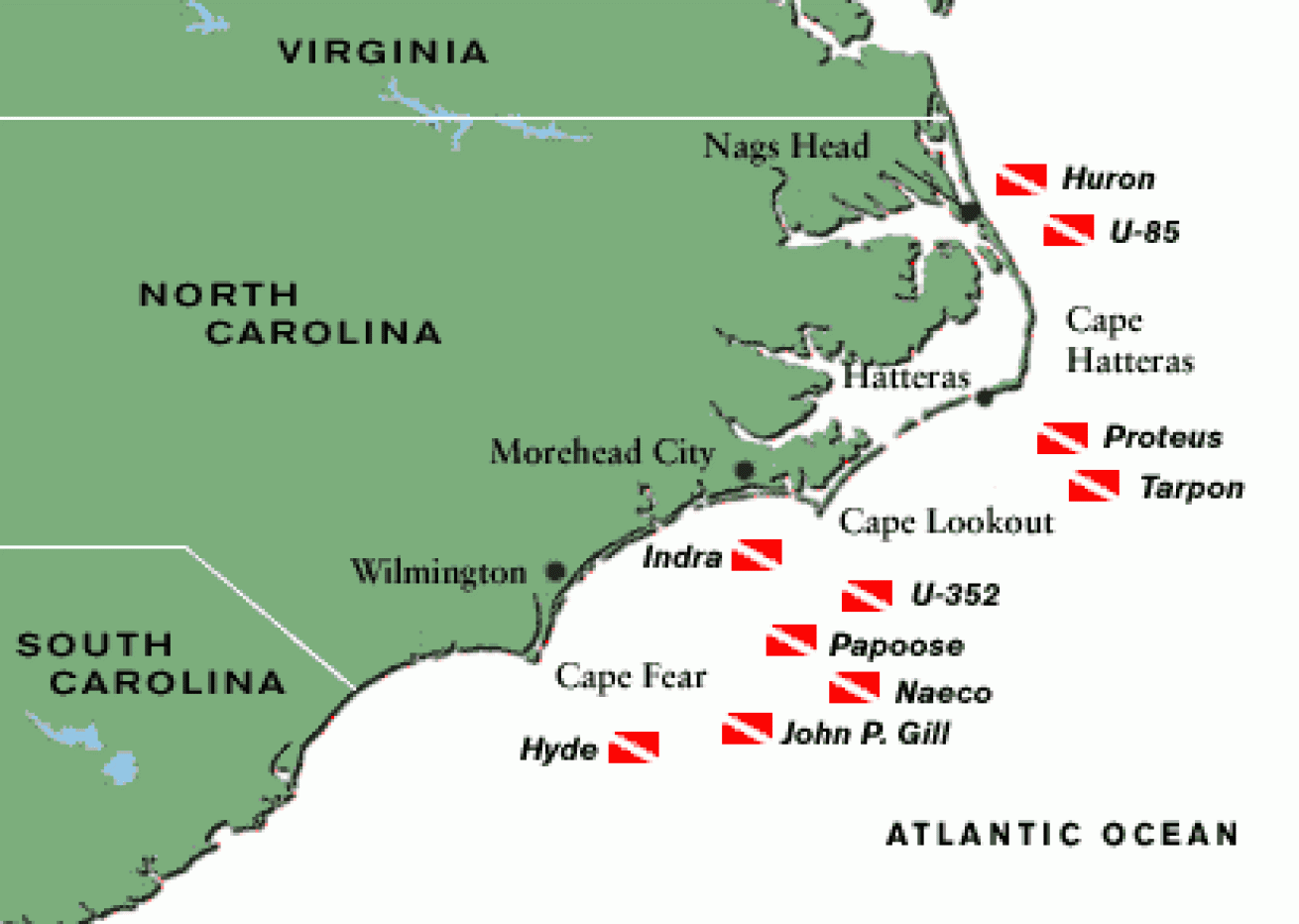
|
Dive Conditions
Diving the North Carolina coast can be terrific or it can be tricky, thanks to conflicting ocean currents that flow past the protruding coastline. Flowing north, the warm blast of the Gulf Stream comes closer to shore here than anywhere north of Florida. From the north flows the cold, green Labrador Current. The two generally meet at Cape Hatteras. Count on clearer, warmer and calmer water south of the Cape, colder, greener water plus stronger currents north of it.
- Surface conditions are unpredictable and can turn from flat calm to flat out calamity. Dive operators will cancel trips when conditions are too rough, but even when conditions are good, you might be in for a bumpy ride to the offshore sites. If you are susceptible to seasickness--and even if you aren't--a precautionary dose of Dramamine is a good idea, especially on smaller boats.
- Visibility averages 50 to 70 feet on most offshore sites, but can peak at 100 or more in the very best conditions, especially during the summer dive season when the Gulf Stream meanders closer to shore.
- Water temperature ranges from the low 70s to low 80s during the summer dive season (May to October), dropping to low 60s in winter. During summer, a full 3mm suit is recommended over shorties, to have added protection from cuts and scrapes. In the winter, plan on a dry suit or heavy neoprene and a hood.
- Currents vary according to conditions, season and sites. Dive operators will brief you on-site. Use caution when swimming near wreck openings as they can amplify currents.
Cape Lookout
U-352
Depth: 115 feet.
Skill Level: Advanced.
The most famous of three submarine dives off the Carolina coast, this World War II German U-boat was hunting Allied shipping in 1942 when she fired on--and missed--the Coast Guard Cutter Icarus. Big mistake. The cutter responded with a barrage of depth charges that killed 13 of the sub's crew and forced the U-boat to surface and surrender. After rounding up the surviving crew, Icarus turned her deck guns on the sub, sending her to the bottom for the final time.
Though her outer hull has long since rusted away, the inner hull is largely intact and encrusted with coral growth. Descending the anchor line to the wreck, it's easy to make out the cigar shape on the white sand bottom, though the lines may seem a bit fuzzy. Like most Carolina wrecks, the U-352 is a rare oasis of structure on the sand bottom and attracts swarms of baitfish seeking protection from predatory jacks.
The sub is half-buried and listing 45 degrees to starboard, but is still the classic picture of a U-boat. You can make out the shape of the conning tower, see the deck gun mounts and find open hatches. Just remember the first rule of Carolina wreck diving--never penetrate a wreck without proper training, equipment and experience.
Papoose
Depth: 120 feet.
Skill Level: Intermediate.
Blown apart by a U-boat torpedo in 1942, the tanker Papoose lies upside down on the sandy ocean floor, broken into sections. You can spend several dives just exploring the wreckage, but most divers get distracted early by the big sand tiger sharks that call the wreck home. Their size and rows of jagged teeth give these sharks a ferocious appearance, but they are generally docile. Their reaction to divers is often one of curiosity, and their mellow demeanor means you can get close for the pictures of a lifetime. Look for them on the wreck, which rises to 90 feet in spots, or on the sand at 120.
Indra
Depth: 65 feet.
Skill Level: Beginner.
Proof that not every great wreck dive has origins in tragedy, this former landing craft repair ship was sunk in 1992 as an artificial reef. She now sails upright and intact through the sand. Upper decks top out at a beginner-friendly 35 feet and Indra makes a great introduction to wreck diving for new divers. Located closer to shore, the wreck is easier to get to than most, but the vis is also lower.
Naeco
Depth: 140 feet.
Sill Level: Advanced.
Broken by a U-boat's torpedo, the Naeco sank in two sections two miles apart. The stern is the more interesting dive with open hull plates exposing a massive engine. Naeco is "ocean" spelled backwards--fitting for a wreck that lies at the very edge of the Gulf Stream. Constantly awash in warm water, the wreck is covered in a riot of tropical marine life. Look for butterflyfish, triggerfish, lobsters, grouper and morays. The long boat ride makes this less crowded than other wrecks, and the visibility is as good as it gets.
Cape Fear
Hyde
Depth: 80 feet.
Skill Level: Beginner.
Sunk in 1988, this artificial reef is covered with colorful growth as well as swirling schools of silver baitfish and colorful tropicals. Huge grouper also live on the Hyde, making it as popular with fishermen as divers, so watch for lures and lines. The wreck is nearly intact and there are plenty of diver-safe swim-throughs on deck.
John D. Gill
Depth: 90 feet.
Skill Level: Intermediate.
At 525 feet, this tanker is the largest ship sunk by a U-boat off North Carolina. She rests in two pieces, broken ahead of the stern. The ship's debris--anchor chain, tools from the deck, a gun platform--litter the bottom. The bow section has settled to one side, partially sunken into the sand. There are enough interesting features on and above deck that divers do not have to descend to the bottom to fully enjoy the dive. A half century of coral growth adds color and texture to the wreck and thousands of fish call it home. Look for amberjack, flounder and Atlantic spadefish.
Nags Head
USS Huron
Depth: 20 feet.
Skill Level: Intermediate to advanced.
An iron hulled steam-and-sail war sloop, the Huron was headed to Havana in 1877 when she ran aground on the shoals off Nags Head. A rare dive in the surf zone (expect strong surge and vis less than 10 feet), the wreck is now a Historic Shipwreck Preserve. The lower half of the Huron's iron hull is well-preserved and covered in coral growth, but shifting sands make the wreck a different dive every time. Wreckage, including cannon balls, the large four-blade propeller and the ship's rudder, is scattered through the site. Full wetsuits and gloves are recommended due to the cool water and surf action.
U-85
Depth: 100 feet.
Skill Level: Intermediate to advanced.
Nicknamed the Wild Boar, U-85 was the first German submarine sunk in American waters. Blasted by depth charges and raked with deck gun and machine gun fire, the sub was in sad shape when she went down. The sea has since peeled away the outer hull and replaced it with living layers of soft coral and algae over the intact pressure hull.
Divers reach the conning tower at 80 feet and the sand at 100 where the sub wallows on her starboard side, deck hatches open and her deck gun still pointed defiantly toward the surface. U-85's position around the corner of the Outer Banks means she's exposed to cooler, greener water of the Labrador Current, so expect strong currents, summer water temperatures of 55F to 60F and visibility hovering somewhere around 30 feet.
Cape Hatteras
USS Tarpon
Depth: 140 feet.
Skill Level: Advanced.
The Tarpon is a U.S. submarine that spent World War II in the Pacific, sinking nine Japanese ships and one German warship. Retired and then sold for scrap in 1957, she was being dragged to the cutting yard when the tow cable broke and the sub made a final dive for the bottom. The years have not been kind to this stubborn American hero--her bow is broken and her conning tower sheared off by drag nets, but the sub is still a popular dive. Though deep by recreational standards and swept by strong currents, visibility is usually very good.
Proteus
Depth: 120 feet.
Skill Level: Advanced.
Proteus was a passenger steamer that ferried travelers from New Orleans to New York. On a foggy August morning in 1918, she collided head-on with the tanker Cushing. The tanker survived and rescued all aboard the Proteus before she sank to the bottom less than half a mile from where the Tarpon would sink 40 years later. A popular dive among artifact collectors, the ship also sports more than 80 years of coral growth and serves as a haven for tropical fish.

